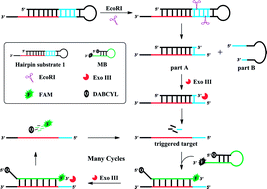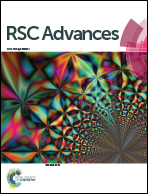A facile fluorescence method for endonuclease detection using exonuclease III-aided signal amplification of a molecular beacon†
Abstract
An exonuclease III (Exo III)-aided signal amplified endonuclease detection strategy was developed by employing a hairpin DNA as the substrate for endonucleases. In the presence of endonucleases, the elaborately designed stem-loop substrate was cleaved into two parts. With the help of Exo III, a single-stranded target of a molecular beacon (MB) probe was released. Subsequently, the MB would hybridize with this target to form a double-stranded DNA, opening its hairpin structure and thereby resulting in the restoration of the fluorescence signal. Owing to the presence of a recessed 3′ terminus in the formed double-stranded DNA, Exo III-aided recyclable cleavage of MBs was achieved. Eventually, an amplified fluorescence signal was observed. As a proof of concept, the fluorescence sensor of endonuclease EcoRI was designed. Under the optimized conditions, the fluorescence intensity is linear with EcoRI activity over the wide range of 1 to 80 U mL−1, with a detection limit of 0.57 U mL−1. Besides, detection of BamHI activity with satisfactory results was achieved by simply changing the endonuclease recognition sequence in the unlabelled substrate, demonstrating that the design concept can be widely adapted to other restriction endonuclease activity analysis.



 Please wait while we load your content...
Please wait while we load your content...